
A 17th Century Blanc de Chine Porcelain ‘Libation Cup’
A Fine 17th Century Blanc de Chine Porcelain octagonal wine cup with incised ‘An Hua’ decoration depicting the ‘Eight Horses of Mu Wang’. Chongzhen to Kangxi period c.1640-1700, Dehua Kilns, Fujian Province.
SOLD
- Condition
- A small shallow chip, mostly glaze, to one corner c.2 x 3 mm. A small dark firing fault to the rim.
- Size
- Diameter : 9.2 cm (3 1/2 inches) Height : 5.2 cm (2 inches)
- Provenance
- N/A
- Stock number
- 25188
- References
- For a very similar 17th century Blanc de Chine cup see : Blanc de Chine, Porcelain From Dehua, A Catalogue of the Hickley Collection, Singapore (Rose Kerr & John Ayers, Art Media Resources Ltd, 2002) plate 107.
Information
Libation Cups :
Blanc de Chine cups of this type have been traditionally referred to as `Libation Cups`. This is unlikely to be correct but their shape follows that of rhinoceros horn cups which was made locally, it is interesting baring in mind the important powers that the Chinese attach to this material. By having a Blanc de Chine cup of this form some of the powers of real rhinoceros horn might be conveyed to the drinker.
The Eight Horses of Mu Wang :
Tsao Fu, in ancient Chinese Mythology, was an exceptionally skilled charioteer, who is said to have lived around 950 B.C. The Chinese tell the story of the Emperor Mu Wang, who was determined to visit paradise. He wanted to taste the peaches of immortality there. He found a very brave charioteer named Tsao Fu, who drove eight amazing horses with great skill. Tsao Fu was afraid of nothing—he carried the emperor across the Earth and into the heavens. The emperor finally reached Mount K’uen Lun and tasted the peaches of immortality. His brave charioteer Tsao Fu was carried up to the stars, where both he and his eight horses can be seen among the stars of the constellation Cepheus. The star Zeta Cephei is specifically named after him.
Blanc de Chine Porcelain :
The porcelain known in the West as Blanc de Chine was produced 300 miles south of the main Chinese kiln complex of Jingdezhen. The term refers to the fine grain white porcelain made at the kilns situated near Dehua in the coastal province of Fujian, these kilns also produced other types of porcelain. A rather freely painted blue and white ware, porcelain with brightly coloured `Swatow` type enamels as well as pieces with a brown iron-rich glaze. However it is the white blanc de Chine wares that have made these kilns famous. The quality and colour achieved by the Dehua potters was partly due to the local porcelain stone, it was unusually pure and was used without kaolin being added. This, combined with a low iron content and other chemical factors within the body as well as the glaze, enabled the potters to produce superb ivory-white porcelain.
A Related Blanc de Chine Cup with Raised Decoration
A Fine 17th Century Blanc de Chine Porcelain Octagonal Cup, Late Chongzhen to Early Kangxi, Dehua Kilns Fujian Province c.1640-1700. With Moulded Raised Decoration of the Eight Horses of Mu Wang. The Glaze Colour is of a Slightly Blue Hue.
Sold by R and G McPherson Antiques
stock number 23011.









